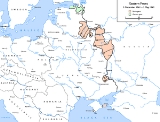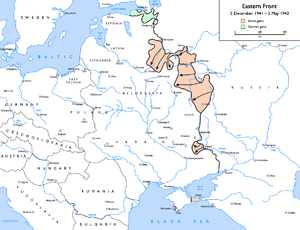
Battles of Rzhev
Encyclopedia

World War II
World War II, or the Second World War , was a global conflict lasting from 1939 to 1945, involving most of the world's nations—including all of the great powers—eventually forming two opposing military alliances: the Allies and the Axis...
offensives launched during January 8, 1942—March 31, 1943 by the Soviet Red Army
Red Army
The Workers' and Peasants' Red Army started out as the Soviet Union's revolutionary communist combat groups during the Russian Civil War of 1918-1922. It grew into the national army of the Soviet Union. By the 1930s the Red Army was among the largest armies in history.The "Red Army" name refers to...
in the general directions of Rzhev
Rzhev
Rzhev is a town in Tver Oblast, Russia, southwest of Staritsa and from Tver, on the highway and railway connecting Moscow and Riga. It is the uppermost town situated on the Volga River. Population:...
, Sychevka and Vyazma
Vyazma
Vyazma is a town and the administrative center of Vyazemsky District of Smolensk Oblast, Russia, located on the Vyazma River, about halfway between Smolensk and Mozhaysk. Throughout its turbulent history, the city defended western approaches to the city of Moscow...
against a German
Nazi Germany
Nazi Germany , also known as the Third Reich , but officially called German Reich from 1933 to 1943 and Greater German Reich from 26 June 1943 onward, is the name commonly used to refer to the state of Germany from 1933 to 1945, when it was a totalitarian dictatorship ruled by...
salient in the vicinity of Moscow
Moscow
Moscow is the capital, the most populous city, and the most populous federal subject of Russia. The city is a major political, economic, cultural, scientific, religious, financial, educational, and transportation centre of Russia and the continent...
, known as the "Rzhev meat grinder" ("Ржевская мясорубка") for these battles' huge losses.
This part of the Second World War was poorly covered by Soviet military historiography
Historiography
Historiography refers either to the study of the history and methodology of history as a discipline, or to a body of historical work on a specialized topic...
, and what coverage exists occurred only after the dissolution of the Soviet Union
Dissolution of the Soviet Union
The dissolution of the Soviet Union was the disintegration of the federal political structures and central government of the Union of Soviet Socialist Republics , resulting in the independence of all fifteen republics of the Soviet Union between March 11, 1990 and December 25, 1991...
, when historians gained access to relevant documents. Exact dates of particular battles, their names, outcomes, significance, and even losses have not been fully clarified.
A reminder of these nameless battles is the poem by Aleksandr Tvardovsky
Aleksandr Tvardovsky
Aleksandr Trifonovich Tvardovsky was a Soviet poet, chief editor of Novy Mir literary magazine from 1950 to 1954 and 1958 to 1970...
which contains the evocative phrase I was killed near Rzhev... (Я убит подо Ржевом, (1945-1946)).
The major operations that were executed as part of the strategic offensive were:
- Rzhev-Vyazma Strategic Offensive Operation (08.01-20.04.42) of the Kalinin FrontKalinin FrontThe Kalinin Front was a Front of the Soviet Army during the Second World War. This sense of the term is not identical with the more general usage of military front which indicates a geographic area in wartime, although a Soviet Front may operate within designated boundaries.The Kalinin Front was...
, Western FrontSoviet Western FrontThe Western Front was a Front of the Red Army, one of the Red Army Fronts during the Second World War. This sense of the term is different from the more general usage of military front which indicates a geographic area in wartime, although a Soviet Front usually operates within designated...
, Bryansk FrontBryansk FrontThe Bryansk Front was a Front of the Soviet Army during the Second World War.General Andrei Yeremenko was designated commander of the Front when it first formed in mid-late August 1941, comprising, in Erickson's words, 'on paper two armies, 50th and 13th, with eight rifle divisions each, three...
, and Northwestern Front- Sychevsk-Vyazma offensive operation (08.01-20.04.42) of the Kalinin Front
- Mozhaisk-Vyazma offensive operation (Operation Jupiter) (10.01-28.02.42) of the Western Front
- Toropets-Kholm Offensive Operation (09.01-06.02.42) of the Northwestern Front and re-assigned to the Kalinin Front from 22.01.42
- Vyazma airborne desant operation (18.01-28.02.42) (see also Operation HannoverOperation HannoverOperation Hannover or Operation Hanover was a German operation in April–June 1942 aimed at eliminating Soviet partisans, airborne troops and encircling Red Army soldiers near Vyazma...
) of the Western Front - Rzhev operation (03.03-20.04.42)
- Operation Seydlitz (02.07-23.07.42) launched by 9th Army of Germany to eliminate the salient in the vicinity between Bely and Kholm-ZhirkovskyKholm-ZhirkovskyKholm-Zhirkovsky is an urban locality in Kholm-Zhirkovsky District of Smolensk Oblast, Russia, located northeast of Smolensk, about west of Moscow, and from the Moscow-Minsk highway. Population:...
and annihilate the 39th Army39th Army (Soviet Union)The 39th Army was a Field Army of the Soviet Union's Red Army formed on 15 November 1941 in the Arkhangelsk Military District, in accordance with a directive issued by the Stavka on 2 November 1941...
and 11th Cavalry Corps11th Cavalry Corps (Soviet Union)The 11th Cavalry Corps of the Soviet Union's Red Army was a cavalry corps active during the Second World War.It was created on 12 January 1942 at Kalinin Oblast...
of the Kalinin Front - First Rzhev-Sychevka Offensive Operation (30.07.42-23.08.42, other sources say ending on 30.09 or 01.10 in 1942) by the forces of the Kalinin Front and Western Front
- Second Rzhev-Sychevka Offensive Operation (Operation Mars) (25.11-20.12.42) by the forces of the Kalinin Front and Western Front
- Battle for Velikiye Luki (24.11.42-20.01.43) by 3rd Shock Army of the Kalinin Front
- Third Rzhev-Sychevka Offensive Operation (Operation Büffel) (02.03-31.03.43) by the forces of the Kalinin Front and Western Front
- At the same time, the southern flank offensive operations on the Bryansk Front
Rzhev-Vyazma Strategic Offensive Operation
During the Soviet winter counter-offensive of 1941, and the Rzhev-Vyazma Strategic Offensive Operation (8 January 1942 - 20 April 1942), German forces were pushed back from MoscowMoscow
Moscow is the capital, the most populous city, and the most populous federal subject of Russia. The city is a major political, economic, cultural, scientific, religious, financial, educational, and transportation centre of Russia and the continent...
. As a result, a salient
Salients, re-entrants and pockets
A salient is a battlefield feature that projects into enemy territory. The salient is surrounded by the enemy on three sides, making the troops occupying the salient vulnerable. The enemy's line facing a salient is referred to as a re-entrant...
was formed along the front line in the direction of the capital, which became known as the Rzhev-Vyazma Salient. It was strategically important for the German Army Group Centre
Army Group Centre
Army Group Centre was the name of two distinct German strategic army groups that fought on the Eastern Front in World War II. The first Army Group Centre was created on 22 June 1941, as one of three German Army formations assigned to the invasion of the Soviet Union...
due to the threat it posed to Moscow, and was therefore heavily fortified and strongly defended.
Soviet forces along the Kalinin Front and Western Front broke through the German lines west of Rzhev in January, but because of a difficult supply route the troops of the Soviet 22nd Army
22nd Army (Soviet Union)
The 22nd Army was a field army of the Russian Ground Forces, part of the Moscow Military District. It was active from 1941 to 2010. The order for the formation's dissolution was signed by the Minister of Defence on 1 July 2009....
, 29th Army
29th Army (Soviet Union)
The Soviet Red Army's 29th Army was a field army of the Red Army and later the Russian Ground Forces.- History :It was first formed in July 1941 in the Moscow Military District on the basis of 30th Rifle Corps. The 245th, 252nd, 254th and 256th Rifle Divisions, and a number of smaller units made up...
and 39th Armies became encircled. To eliminate this threat to the rear of the German 9th Army, the Germans had started Operation Seydlitz by the 2nd of July.
Operation Seydlitz
This operation resulted in the complete elimination of the trapped Soviet forces on 12 July, the attempted rescue of 2nd Shock Army (13 May 1942 - 10 July 1942) and the Rzhev-Sychevka Offensive Operation (30 July 1942 - 23 August 1942). The front line around the salient was pushed closer to the city of Rzhev by Wehrmacht forces. During this period, the city of ZubtsovZubtsov
Zubtsov is a town and the administrative center of Zubtsovsky District of Tver Oblast, Russia, located at the confluence of the Volga and Vazuza Rivers, south of Tver, southeast of Rzhev, and southwest of Staritsa. Population: 8,100 ....
was liberated by the Red Army.
Rzhev-Sychevka Strategic Offensive Operation (Operation Mars)
The next Rzhev-Sychevka Offensive (25 November 1942 - 20 December 1942) codenamed Operation MarsOperation Mars
Operation Mars was the codename for the Rzhev offensive operation part of the Rzhev-Vyazma strategic offensive operation launched by Soviet forces against German forces during World War II. It took place between 25 November and 20 December 1942 in a salient in the vicinity of Moscow...
.
the operation consisted of several incremental offensive phases
- Sychevka Offensive Operation 24 November 1942 - 14 December 1942
- Belyi Offensive Operation 25 November 1942 - 16 December 1942
- Luchesa Offensive Operation 25 November 1942 - 11 December 1942
- Molodoi Tud Offensive Operation 25 November 1942 - 23 December 1942
- Velikie-Luki Offensive Operation 24 November 1942 - 20 January 1943
This operation was nearly as heavy in losses for the Red Army as the first offensive, and also failed to reach desired objectives, but the Red Army tied down German forces which may have otherwise been used to try and relieve the Stalingrad garrison, which was fighting for its life in Stalingrad
Battle of Stalingrad
The Battle of Stalingrad was a major battle of World War II in which Nazi Germany and its allies fought the Soviet Union for control of the city of Stalingrad in southwestern Russia. The battle took place between 23 August 1942 and 2 February 1943...
.
The information about offensive was provided to OKH by an NKVD
NKVD
The People's Commissariat for Internal Affairs was the public and secret police organization of the Soviet Union that directly executed the rule of power of the Soviets, including political repression, during the era of Joseph Stalin....
double agent known as Heine as part of the plan to distract German forces from Stalingrad.
However, due to the general course of the war, Hitler ordered German forces to withdraw from the salient in March, 1943 during Operation Büffel
Operation Büffel
During World War II the name Büffel Bewegung was given to a series of local retreats conducted by the German Army on the Russian Front during the period 1–22 March 1943. This movement eliminated the Rzhev Salient and shortened the front by 230 kilometers, releasing twenty-one divisions for use...
. The Stavka used this as an opportunity to pursue the retreating Wehrmacht troops.
Losses
For the whole series of Rzhev battles, the numbers are not clear but the total Soviet losses are estimated at between 500,000 and 1,000,000 men. German losses are estimated at between 300,000 and 450,000 men.In the words of author David Glantz: "In the unlikely event that Zhukov was correct and Mars was really a diversion, there has never been one so ambitious, so large, so clumsily executed, or so costly".

